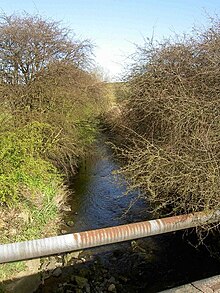River Went
| River Went | |
|---|---|

The river seen from Standing Flat bridge
|
|
| Country | England |
| Basin features | |
| Main source |
Streethouse 160 feet (49 m) |
| River mouth |
River Don, Reedholme Common 0 feet (0 m) |
The River Went is a river in Yorkshire, England. It rises close to Featherstone and flows eastward, joining the River Don at Reedholme Common.
A possible site of the Battle of Winwaed is believed to be located somewhere along the valley of the Went.
The river rises at Streethouse, just to the west of Featherstone, and close to the 160-foot (49 m) contour. It is called Went Beck at this point, and flows generally eastwards, to the south of Featherstone. Just before it is crossed by the B6428 at Little Went bridge, it is joined by Hardwick Beck, flowing north-eastwards from the lakes of Nostell Park, once the site of Nostell Priory, but now containing a grade I listed Palladian house owned by the National Trust. It then flows between High Ackworth and Ackworth Moor Top, before being crossed by Low Ackworth railway viaduct.
Continuing eastwards, it is crossed by the A639 road, which follows the course of a Roman road at this point. The bridge is called Standing Flat bridge, and is just to the north of Thorpe Audlin. The next crossing is the B6474 as it enters Wentbridge. The grade II listed bridge has two arches, made of rockfaced magnesian limestone and sandstone ashlar blocks, and is probably early nineteenth century. The A1 road bypasses Wentbridge to the east, and is carried over the river by Wentbridge viaduct. This was designed by F A Sims, who was the senior designer and resident engineer for the bridges department of the West Riding County Council, and it was opened in 1961. It consists of a continuous beam, supported at its ends and by two sloping legs, which are hinged at both ends. The side spans are 140 feet (43 m) long, while the centre span is 190 feet (58 m) long. It was probably the first bridge in England to use prestressing cables which did not pass through the concrete sections, and one of the first to use precast concrete hinges. When it was built, it was the largest bridge of this kind in Europe, and in 1964 the New York City Museum of Modern Art declared it to be a structure of significance in twentieth century engineering. It is grade II listed.
...
Wikipedia
